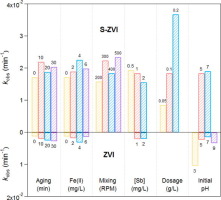Chemical Engineering Journal ( IF 13.3 ) Pub Date : 2018-01-08 , DOI: 10.1016/j.cej.2018.01.033 Shasha Huang , Chunhua Xu , Qianqian Shao , Yahao Wang , Bingliang Zhang , Baoyu Gao , Weizhi Zhou , Paul G. Tratnyek

|
Zerovalent iron (ZVI) is commonly used for water treatment under aerobic conditions such as sequestration of metals. Sulfide-modified ZVI (S-ZVI) is attracting increasing attention for its easy preparation and high reactivity with environmental pollutants. The processes responsible for contaminant removal can be a complex mixture of redox, sorption, and coprecipitation processes. In this paper, ZVI and S-ZVI were used to sequester antimonite (Sb(III)). The rates of Sb(III) sequestration were determined in open, well-mixed, batch reactors. The effects of various experimental variables were investigated, including pH, iron dose, initial concentrations of Sb(III), aging time of the ZVI and S-ZVI, addition of Fe2+, mixing rate, etc. The results showed that S-ZVI can significantly enhance the Sb(III) sequestration, and under basic conditions in this study, the kobs (0.018 min−1) obtained in the S-ZVI system was approximately 15 times higher than the 0.0012 min−1 obtained in the ZVI system. Solid phase characterizations were conducted to assess the influence of sulfidation on the morphology and surface geochemistry of ZVI. Scanning electron microscopy (SEM) coupled with energy-dispersive X-ray spectroscopy (EDS) confirmed the presence of sulfur. X-ray photoelectron spectroscopy (XPS) indicated the oxidation of Sb(III) to Sb(V) and adsorption and coprecipitation onto the iron oxides is the mainly sequestration process. The FeS layer on ZVI is more conductive than oxides and therefore accelerates electron transfer. In addition sulfidation promotes the corrosion of iron and the formation of ferrous iron, which further enhances the ferric iron oxide formation, thereby favoring adsorption and oxidation of Sb(III).
中文翻译:

硫化物改性的零价铁,用于增强锑矿螯合:表征,性能和反应机理
零价铁(ZVI)通常用于有氧条件下的水处理,例如金属螯合。硫化物改性的ZVI(S-ZVI)易于制备且对环境污染物具有高反应活性,因此受到越来越多的关注。负责去除污染物的过程可能是氧化还原,吸附和共沉淀过程的复杂混合物。在本文中,ZVI和S-ZVI被用于螯合锑矿(Sb(III))。在开放的,充分混合的间歇反应器中确定了Sb(III)螯合的速率。研究了各种实验变量的影响,包括pH,铁剂量,Sb(III)的初始浓度,ZVI和S-ZVI的老化时间,添加的Fe 2+结果表明,S-ZVI可以显着增强Sb(III)的螯合,在本研究的基本条件下,S-ZVI系统获得的k obs(0.018 min -1)约为15。比0.0012 min -1高出1倍在ZVI系统中获得。进行固相表征以评估硫化对ZVI形态和表面地球化学的影响。扫描电子显微镜(SEM)结合能量色散X射线光谱(EDS)证实了硫的存在。X射线光电子能谱(XPS)表明,Sb(III)氧化为Sb(V),并且在铁氧化物上的吸附和共沉淀是主要的螯合过程。ZVI上的FeS层比氧化物更具导电性,因此加速了电子转移。另外,硫化促进了铁的腐蚀和亚铁的形成,这进一步增强了三氧化二铁的形成,从而有利于Sb(III)的吸附和氧化。











































 京公网安备 11010802027423号
京公网安备 11010802027423号